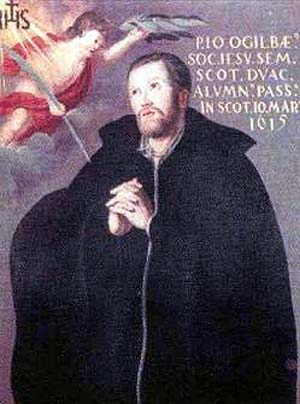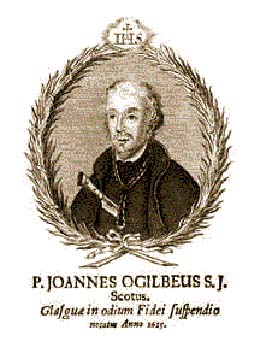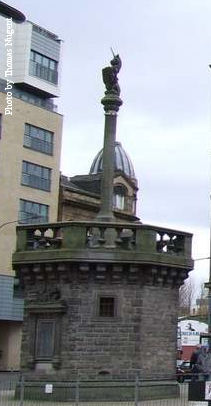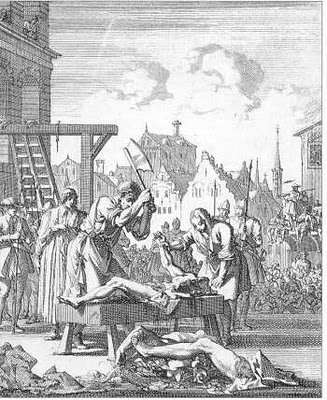 Ogilvie, the son of a wealthy noble, was born into a Calvinist family near Keith in Banffshire, Scotland and was educated in mainland Europe where he attended a number of Roman Catholic educational establishments, under the Benedictines at Regensburg in Germany and with the Jesuits at Olomouc and Brno in the present day Czech Republic.
Ogilvie, the son of a wealthy noble, was born into a Calvinist family near Keith in Banffshire, Scotland and was educated in mainland Europe where he attended a number of Roman Catholic educational establishments, under the Benedictines at Regensburg in Germany and with the Jesuits at Olomouc and Brno in the present day Czech Republic.
Mercat cross. The Mercat Cross stands at the south-eastern corner of Glasgow Cross. It is a monument to St. John Ogilvie and was commissioned for construction in 1929–30 by William George Black, and designed by the architect Edith Hughes.
In the midst of the religious controversies and turmoil that engulfed the Europe of that era he decided to become a Roman Catholic. In 1596, aged seventeen, he was received into the Roman church at Louvain, Belgium by Father Cornelius a Lapide. He joined the Society of Jesus in 1608 and was ordained a priest in Paris in 1610. After ordination he made repeated entreaties to be sent back to Scotland to minister to the few remaining Roman Catholics in the Glasgow area (after the Scottish Reformation in 1560 it had become illegal to preach, proselytise for, or otherwise endorse Roman Catholicism).
 He returned to Scotland in November 1613 disguised as a soldier, and began to preach in secret, celebrating mass clandestinely in private homes, mostly among his fellow nobility. However, his ministry was to last less than a year. In 1614, he was betrayed and arrested in Glasgow and taken to jail in Paisley. He suffered terrible tortures, including being kept awake for eight days and nine nights, in an attempt to make him divulge the identities of other Roman Catholics. Nonetheless, Ogilvie did not relent; consequently, after a biased trial, he was convicted of high treason for refusing to accept the King’s spiritual jurisdiction. On 10 March 1615, aged 36 years, John Ogilvie was paraded through the streets of Glasgow and lawfully hanged at Glasgow Cross.
He returned to Scotland in November 1613 disguised as a soldier, and began to preach in secret, celebrating mass clandestinely in private homes, mostly among his fellow nobility. However, his ministry was to last less than a year. In 1614, he was betrayed and arrested in Glasgow and taken to jail in Paisley. He suffered terrible tortures, including being kept awake for eight days and nine nights, in an attempt to make him divulge the identities of other Roman Catholics. Nonetheless, Ogilvie did not relent; consequently, after a biased trial, he was convicted of high treason for refusing to accept the King’s spiritual jurisdiction. On 10 March 1615, aged 36 years, John Ogilvie was paraded through the streets of Glasgow and lawfully hanged at Glasgow Cross.
His last words were “If there be here any hidden Roman Catholics, let them pray for me but the prayers of heretics I will not have”. After he was pushed from the stairs, he threw his concealed rosary beads out into the crowd. The tale is told that one of his enemies caught them and subsequently became a lifelong devout Roman Catholic. After his execution Ogilvie’s followers were rounded up and put in jail. They suffered heavy fines, but none was to receive the death penalty.
Hanged, drawn and quartered. Many of the English, by order of Elizabeth I, were martyred this way.
As a martyr of the Counter-Reformation he was beatified in 1929 and canonized in 1976. He is the only post-Reformation saint from Scotland.
Saint John Ogilvie is commemorated 10 March.
Tagged as: England, Forty Martyrs of England and Wales, Honor, Martyr, Nobility, Royal and Noble Saints, Saints





No comments:
Post a Comment